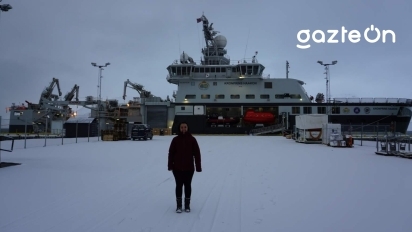Artic and Climate Change
<p> Naima El Bani Altuna, whose mother is from Bergara and father from Casablanca, is a 28-year-old native of Bilbao who never imagined herself in the Arctic. She chose geology out of curiosity, because she didn't really know what she wanted to study. She knew she wanted to do something related to the sea and that she could give something back to society.</p>

Why in the Arctic? What is so special about it?
I started Geology at the University of the Basque Country and then I discovered that, by investigating what the sea was like in the past, I could study climate change. To continue on this line, I did a master's degree in Palaeoceanography at the University of Bordeaux. Initially, my intention was to work on something to do with the Bay of Biscay or the oceanographic evolution of the Atlantic coast of Morocco, but at the last minute, by chance, I was given some sediments to study the Canadian Arctic and so I ended up there.
I don’t know what it was about that job that got me totally hooked. As I said, I wanted to research a site closer to my personal history, but researching the Arctic opened new doors for me. Until then, the book "A chair in the snow" by Uxue Alberdi was the only reference I had to the north: frozen, white, very quiet, unknown, sometimes dark and sometimes full of light landscapes. Today my life takes place in this type of landscape and I like it very much. That is on a personal level. As far as science is concerned, the Arctic is very special. Many people think that nobody lives up here, just a few polar bears, and that what happens here will not affect anyone (and that is totally wrong!). Moreover, the Earth is not organised in totally disconnected compartments, so changes that occur in the Arctic as a result of climate change will affect the other side of the world due to atmospheric and oceanic circulation.
“Look to the past to understand the future” is what you say on your twitter profile. Relating the phrase to your thesis, what would you say will help us understand what you have studied?
Thanks to the research on the gas bubbles stored in Greenland's ice, we know that in the last Ice Age, there were episodes of abrupt warming, with temperature increases between 5°C and 16.5°C in a few decades. The warming rates are comparable in magnitude to current ones. These episodes cooled progressively, ending with a cold and stable cooling period. These episodes are called Dansgaard-Oeschgard events. Due to this, the graph of atmospheric temperatures over the last 120,000 years takes the form of a sawtooth, demonstrating, among other things, that our planet's climate is not very stable.
In the Nordic Seas, deep water is formed, and this is very important to maintain the stability of current ocean circulation. At present, warm and salty waters from the Atlantic enter the Nordic Seas from the south. These (relatively speaking) warm and salty waters are cooled as they circulate northwards by mixing with cold polar water. The newly formed cold and salty water, has a high density, which causes it to sink, returning it southwards. To put it simply, this is like a conveyor belt at the airport. Let's imagine that the suitcases that go on the conveyor belt represent the heat. If the conveyor belt moved faster and faster northwards, more and more suitcases would move from south to north. The same thing happens with the climate, and this shows the relationship between the climate and the ocean: the more cold and salty water circulates to the north (which will determine the strength of the conveyor belt), the more heat will be transported from south to north (this is, more and more suitcases will be transported).
This configuration has not always been like this. In general, during Ice Ages and Dansgaard-Oeschger cooling periods, less deep water is produced, weakening the ocean circulation. In warm periods and at present, the circulation is stronger , so more heat is transported northwards. The temperature of the ocean floor can indirectly tell us whether or not deep cold water is being produced. In my thesis, I have studied the evolution of bottom water (seafloor) temperatures in the Nordic Seas and the Barents Sea during the last Ice Age, in the last 60 thousand years of the Earth’s history. The aim has been to better understand what was happening in the ocean during the Dansgaard-Oeschger events. Why in the past? Because we can investigate the past by analysing the Earth’s sedimentary archives, and that can give us clues about the natural state of the Earth. So we investigate the past in order to understand the different future scenarios a little better. However, to better understand the present and the future, we must add human influence to the equation, and this is is new to Earth’s history.
You have investigated samples from the North. How do these samples differ from those located in the south of the Nordic Sea? Why this choice?
The Nordic Seas are a very interesting place for the reasons mentioned above. The south is a good place to investigate the amount of water coming in and going out. To the north is the Fram Strait, which connects the Nordic Seas and the Arctic Ocean. So the north part of the Nordic Seas is also very interesting to investigate the water exchange that is produced there. All the pieces are needed to build the “ocean-climate” puzzle, but so far much more work has been done in the south than in the north.
The reason why there is more work done in the south is that it is easier to reach, among other things. Until the beginning of this project, there was only work in the north to reconstruct seafloor in the past temperatures using independent geochemical methods. Many places have not been investigated because of the lack of money and infrastructure, not for lack of knowledge nor interest. That's why it's so important to invest in science.
You have been doing research for years. What would you highlight from your research over all these years? What would you emphasise or pay special attention to?
Since I started my PhD I have started a learning process that will never end.
As far as research is concerned, what I would highlight most is the need to research in a multidisciplinary way, and that is difficult (usually impossible). As I said before, the Earth is not divided into distinct compartments, and you realise how important it is to investigate what is happening in other places in order to understand what is happening in your own study area. To understand Arctic geology, it is not enough to study Arctic geology. That's why it's important to collaborate with other teams and try to look beyond your own research.
On a personal level, I have also learned many things about the research world. Research is done by people, and anyone who says that science is objective is not telling the truth. You realise the hierarchical nature of academia and that the same prejudices and dynamics that take place in society, are also reproduced in academia. And also how little we take care of the mental health of researchers; fortunately, we are talking more and more about this, but it is not enough.
In your thesis, you have presented three scientific articles. In a simple and summarised way, what have you deduced?
In the Dansgaard-Oeschger cycles, the atmosphere warmed "abruptly" (in geological time) and cooled progressively, and this was linked to variations of the water temperature in the seafloor. Our results have shown that the warm waters of the Atlantic (5-6°C) could reach a depth of 1200 m in cold stades. In warm periods, as at present, the temperature of the seabed remained cold. This leads us to differentiate between two types of circulation: 1) the current one, in which cold water is generated due to the strong ocean circulation that transports heat from south to north, and 2) the one that occurred in cold periods, in which the production of cold water was reduced and warm water from the Atlantic could "reach" the seabed.
How is it possible for the Atlantic waters to reach such great depths and not lose any heat to the atmosphere on the way? In the last manuscript we looked at the evolution of sea ice in parallel to bottom water temperatures. It is not yet published and we are still working on it, but we see that there is a close relationship between the extent of sea ice and water temperature. The sea ice cover was much wider in colder times, which probably prevented heat loss of the Atlantic waters that flowed beneath. It is possible that the balance between sea ice and incoming Atlantic waters is an important factor in the sudden atmospheric warming. No one knows exactly how it was possible for the atmosphere to warm so rapidly naturally (without human activity), and ocean dynamics probably contributed a lot to this.
Finally, in the Arctic sediments we find a substance called gas hydrates, which are ice-like structures that contain gas (usually methane) "trapped" inside. Gas hydrates are stable at very low temperature and high pressure, so they can be found naturally in the Arctic seafloo. But what would happen if the water temperature at the seafloor was to rise? Many researchers are asking this question because of the current climate change. Knowing that during cooling periods the seafloor temperature increased so much, we looked back in time and found that gas hydrate dissociation may be indirectly related to the increase in seafloor temperatures since the end of the last Ice Age in the Barents Sea (a sea with a maximum depth of 400 m).
Would you like to share moments or experiences of this intense work that are etched in your mind?
The expeditions are the moments I remember the most. It's hard to be away from home, without internet, with a lot of work... but I am very privileged to sail in the beautiful Arctic. I remember when I first saw the sea ice. I knew it existed, but it seemed surreal that I was there, at such a high latitude, in the middle of nowhere and surrounded by frozen seawater, floating on a 4000m column of water.
In your thesis you mention that the uncertainties about future climate projections are large, why? What is the most necessary and appropriate way to deal adequately with this uncertainty?
Ongoing data collection. The uncertainties are large because we do not yet understand a lot of things. Moreover, for projections to work, they need to be "validated". I am not an expert in this but, to put it simply, what these validations do is to evaluate the climate model against a known record. That is, I know that the temperature varied so much from year X to year Y because I have measurements, so I will test my model on top of this record. If my model manages to "mimic" this record, I can think that the future projection may also work. So the first step to make it work is to have a long and reliable record of the past that allows the climate models to be compared with that record. The problem is often that many past records have high errors. In our case, for example, our bottom water temperatures have an error of ± 1 °C.
In many of the scientific papers read recently, it is mentioned that climate projections foresee a further melting of the Arctic ice. What would you say about this?
It's not just that the projections foresee an even greater reduction in the ice cover, these changes are already happening and all the data point in the same direction. We shouldn’t have to wait for these dramatic projections to happen before we do something.
Going back to the "Think global, act local" philosophy, what happens in the Arctic doesn't just stay in the Arctic, does it?
No. As explained above, the climate system is one, and not only that, but it is fully connected to society. Often the image that comes to mind when talking about climate change and the Arctic is that of the poor polar bear standing on a block of ice, but this is not the only consequence of climate change. Climate change, melting ice and human influence on the climate and the environment will cause (and is already affecting) changes not only in polar regions, but also in communities far from the poles, in the food we eat, in our daily lives and in so many other things.
Strategically it is a very good idea to dehumanise climate change putting a polar bear as the main image, but it is not fair because it makes us feel far away from the problem and helps us to take away the responsibility we have ("this is not something that is going to happen here, I am far away, I have nothing to do with it") and because it reduces our motivation for action ("the poor bear is the only victim"). Perhaps my reading is too simplistic, but I agree that to change things in our communities we have to have a global vision, and to change the world we have to start from our neighbourhoods and villages.
Relating your research to sociology, according to sociologist Zygmunt Bauman we are part of the liquid generation. You must have seen first-hand some of the melting of the ice, from solid to liquid, raising sea levels. Do you think we are at a complex turning point?
I had to do some reading about the liquid society to answer this question (yes, scientists don't know everything and Wikipedia is often the page we look at first). I have read that instability, uncertainty and individualism dominate the liquid generation. Translated to climate, climate has always been changing, it has changed between the Ice Age and warmer times. As we have seen above, the Ice Ages also had abrupt warming episodes and, on smaller time scales, climate oscillations can change the climate in a few years, epochs and weeks. Today climate is increasingly unstable because human activity has to be added to natural factors, taking us to an uncertain place. But at the same time, we know thanks to science that Earth’s temperature will increase and how much it will increase depends on our influence and decision making. And I say our, the plural form and not in the singular. Because when we often read what one can do about climate change, they are all individual actions. It is good and necessary to improve the things that one can improve on a personal level, but it is not enough. We have to change collectively, stop putting the main responsibility on individuals and start holding those at the top to account.
From your youth and your knowledge, what is your personal reflection on the challenge of climate change?
I read climate change from a natural science perspective when I am working. But I am also a second-generation immigrant, because my father is Moroccan, and I have been an immigrant in Italy, France, Canada and today in Norway. So it is difficult for me to think exclusively about climate change in a scientific way. I am aware that having a European passport gives me many privileges, among other things, I can move around the world wherever I want without too many problems; but what if I did not have this passport and it would not be possible for me to live in my own country because of climate change? Where and how could I leave? There are many migrants, refugees and asylum seekers for so many reasons, and climate change is increasingly among those reasons. Paradoxically, the people who will suffer most from climate change are not the people most responsible for climate change. Therefore, in addition to the need for measurement and objective scientific data to deal with climate change, we also need climate and social justice.
I'm 28 years old and I'm not looking forward to seeing the world go up in flames as I get older. Maybe I'm a bit naive, but I'm confident that we can do better and that there is still time to build a good and fair future for the planet and for all of us who live on it.



